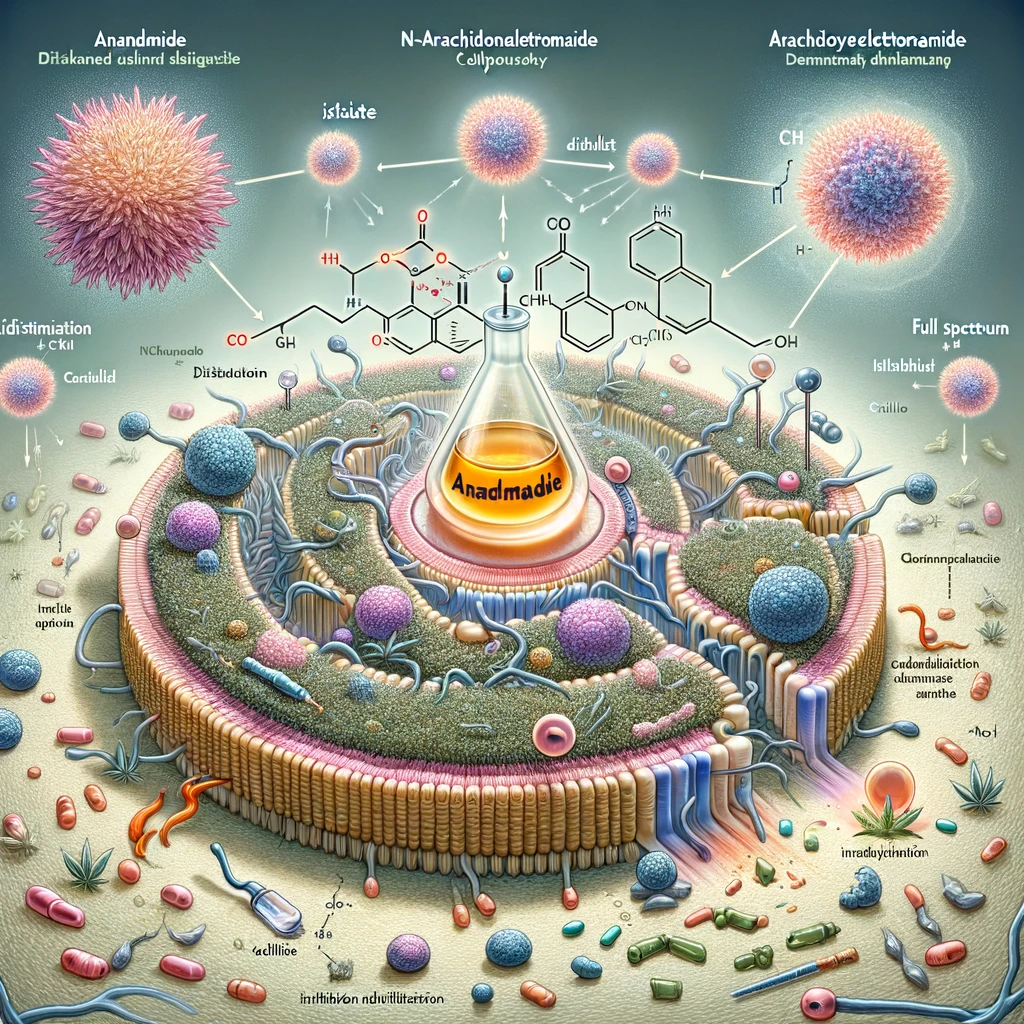Add products by adding codes
Effect of CBD oils on anandamide metabolism Rafal Blazejewski

Author: Rafał Błażejewski
Effect of CBD oils on anandamide metabolism
The hemp industry is the fastest growing industry in the world today. This is due in part to the endocannabinoid system (ECD), which was discovered in the 1990s, and the effects that the phytocannabinoids[1] contained in hemp have on it. In today's supplement market, we have access to many types of hemp extracts, commonly referred to as CBD oils. They differ in their composition and production method, e.g. there are isolates available, where CBD is found solo, distillates with a broader profile of cannabinoids or full spectrum products containing all phytocannabinoids including their acid precursors such as CBDA, CBGA, CBCA, CBDVA, etc. As we know, full spectrum oils have the most beneficial effect on our body, this is stated, for example, by studies that gave rise to the term entourage effect[2] or the achievements of experience-based medicine.
And here the question arises, does it make sense to administer CBD solo if the so-called full spectrum is better? The answer to this question is not clear-cut, it depends on what effect we expect and for whom the preparation is intended. Nevertheless, the purpose of this paper is not to pretend which oil is better, but to draw attention to what therapeutic potential we can achieve by inhibiting anandamide metabolism through phytocannabinoids contained in hemp oils.
As for anandamide itself, whose chemical name is N-arachidonoyl ethanolamide (AEA), it is the best known endocannabinoid[3]. The highest concentration of this substance is found in the brain and it is synthesized from phospholipids (phosphatidylethanolamine, phosphatidylcholine) located in the inner layer of the cell membrane. As for the origin of the word Anandamide, on the other hand, the word comes from the Sanskrit phrase ananda meaning delight, bliss. Probably scientists named it so because it is a psychoactive compound and min. that is why it is secreted during sleep. The cell has produced as many as 4 pathways for the synthesis of anandamide, which means that AEA is of immense importance for our body. In the cell, anandamide acts as an agonist for cannabinoid receptors, mainly the CB1 receptor[4] and to a lesser extent CB2 and TRPV1 receptors. It has been shown that by activating the CB1 receptor, anandamide has an antiproliferative effect, enhances apoptosis of various cancer cells, such as colon, and exerts effects on repair, metabolic or modulatory processes. Activation of the CB2 receptor also contributes to apoptosis. By activating the TRPV1 receptor, anandamide contributes to increased oxidative stress and calpain activation[5], which also leads to apoptosis of, for example, glioma cells.
Endocannabinoids that are not bound to receptors and those that have already fulfilled their role in the cell are degraded. The main enzyme responsible for the metabolism of endogenous AEA is FAAH (fatty acid amide hydrolase). Since anandamide has structural similarity to polyunsaturated fatty acids, in addition to hydrolytic degradation, it can also undergo oxidation involving cyclooxygenase-2. Anandamide is metabolized quite rapidly, although it has also been shown that endocannabinoid metabolites play an important biological role, it would be worthwhile in many disease entities or prophylactically to take care of its higher levels. So how to increase intracellular anandamide levels? As studies show, FAAH regulates intracellular anandamide concentration, so inhibiting its activity increases AEA concentration. To inhibit the activity of FAAH, an inhibitor must be used, and this is where CBD oils come to our aid. Cannabidiol (CBD) itself is not an agonist or antagonist of CB1 and CB2 receptors, but it blocks anandamide metabolism by inhibiting FAAH,[6] which contributes significantly to its intracellular levels.
The second pathway of anandamide metabolism is cyclooxygenase 2 (COX-2), which is also one of the most common factors in the induction of inflammation, when we are sick and take aspirin it is then that we block COX-2. Returning to hemp extracts, scientific research suggests that the compound responsible for inhibiting cyclooxygenase 2 will be naturally occurring cannabidilic acid (CBDA) in hemp[7].
In addition to endocannabinoid metabolism, the cell has developed another solution for getting rid of excess AEA is to eject anadamide into the extracellular space via transporters for endocannabinoids (EMTs) where it is further degraded. Nature has also endowed cannabis with such phytocannabinoids that act to inhibit these transporters and these are cannabidivarin (CBDV), tetrahydrocannabivarin (THCV) as well as cannabigerol (CBG). If we inhibit EMT, the cell won't dump too much anandamide unnecessarily.
Conclusion: knowing the role of anandamide and following its metabolic pathways, we can conclude that cannabis oils can significantly contribute to increasing the intracellular concentration of anandamide, which can improve health and help in many disease entities.
Rafal Blazejewski
Footnotes:
[1] Plant-derived cannabinoids
[2] Entourage effect is a term first used to study the interactions between different compounds present in cannabis, published in the July 1998 issue of the European Journal of Pharmacology. this text was written by scientists including Professor Raphael Mechoulam and Shimon Ben-Shabat and demonstrates the increase in activity of a given cannabinoid due to the presence of another compound, in this case fatty acid esters.
[3] Endocannabinoids are natural compounds that are produced by human and animal organisms.
[4] CB1 receptor is one of the receptors of the endocannabinoid system others are CB2 , TRPV1 and G protein-coupled receptors - GPR18, GPR55, GPR119. Expression of CB1 receptors occurs primarily in the central nervous system, mainly in the centers controlling motility (basal nuclei, cerebellum), memory and learning (cortex and hippocampus), emotions (amygdala), sensory perception (thalamus), and autonomic and endocrine functions (hypothalamus, bridge and medulla oblongata). CB1 receptors are also found in peripheral nerve endings and on the surface of fat cells (adipocytes), in the liver, pancreas, or skeletal muscle
[5] is a protein belonging to the family of calcium-dependent, non-lysosomal cysteine proteases. Degradation of the resulting unfavorable substrates under the influence of cytoplasmic calpains contributes to cellular homeostasis.
[6] https://www.ncbi.nlm.nih.gov/pmc/articles/PMC1573017/#bib53
[7] https://pubmed.ncbi.nlm.nih.gov/18556441/
Recommended

Premicanna PLUS Certified CBD Oil 10% CBD hemp oil fortified with CBG.



